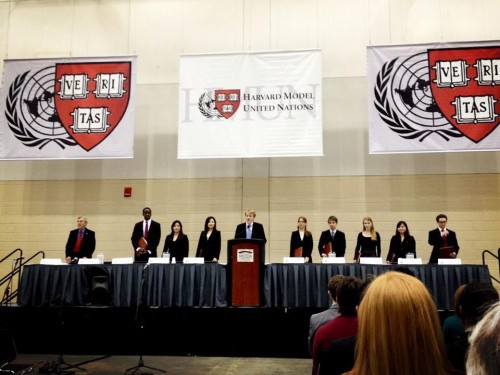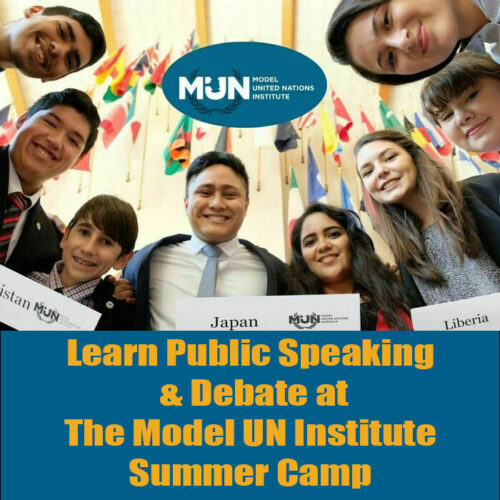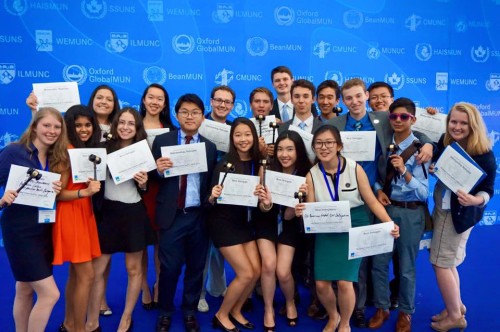
Delegates can win awards in Model United Nations including the coveted gavel. Here, the All-American Team poses with their awards from the WEMUN Expo in China.
Awards exist in Model United Nations and are given out for strong individual and school performance in MUN committees. The existence of awards is controversial because the educational objectives of Model UN are not clearly defined, much less standardized. One educational philosophy believes students thrive and benefit from competing against the best and should be recognized with external validation. Another educational philosophy believes students thrive and benefit in an environment where the focus is on non-competitive learning and collaboration in the true spirit of the United Nations, and that rewards come from intrinsic validation. The philosophies are not mutually exclusive in practice, and most Model UN conferences actually fall somewhere in between. Sometimes, their educational philosophy is even contradicted by the awards given out at their own conferences. This article will explain why awards exist in Model UN and to what extent they exist along a competitive to noncompetitive spectrum.
Why Do Awards Exist in Model UN?
The reason awards exist in Model UN is likely due to historical and cultural reasons and tied to human nature. Humans tend to compete for resources when they are scarce and when cooperation is not a path toward attaining those resources. In American-style education, admissions into top-tier universities such as the Ivy League is a scarce resource and therefore very competitive. In turn, indicators to determine who should be of merit to those scarce university seats has to also be competitive in order to have any value. Awards are one such indicator alongside GPAs, SAT scores, and leadership positions.
Model UN started in the United States, namely at Berkeley MUN and Harvard MUN, and the activity was mostly limited to elite private school students and prestigious university students up until the 1990s. The students who attended these schools and universities have known competition their entire lives and likely had to win awards to gain admission into these universities. When they created Model UN conferences, they merely instilled their values into the activity — awards helped determine who did a good job in Model UN.
Therefore, awards in Model UN do not exist in a vacuum; they are byproducts of a larger educational environment that requires awards as a proxy for merit. This is the reason why awards exist for almost every extracurricular activity in the United States, whether is it Model UN, debate, robotics, band, football, or cheerleading. This is also why participants in China, India, Pakistan, and other highly-populated countries have embraced awards and American-style Model UN conferences — they exist in a highly competitive environment where university admission is a limited resource.
Do Awards Have to Exist in Model UN?
Since awards exist in American-style conferences, it becomes hard for one Model UN conference in a particular circuit to not offer them due to fears of losing their participants to another Model UN conference that does offer them. In an unlikely scenario where every Model UN conference in America decided to not offer awards, the majority of non-hardcore Model UN students would turn to other extracurricular activities that give them opportunities to win awards that help with university admissions, and Model UN would become more educationally pure but would lose the majority of its casual participants. This can already be seen in schools where the Model UN team may have to compete with the debate team or other academic competitions for talent, and most students are likely to select the activity where they could win the most awards.
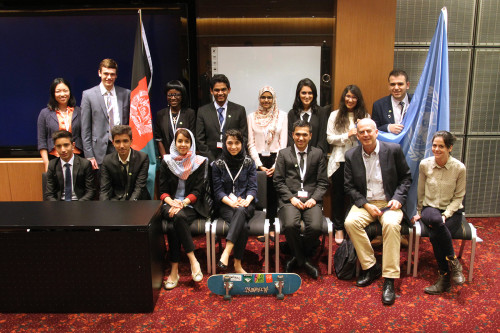
Learning about the world and each other are intrinsic rewards in educationally-focused MUNs. For example, a multinational team of students who attended THIMUN Qatar mentored a group of Afghan students to attend the conference for the first time.
That said, awards do not exist at every Model UN conference, particularly in the THIMUN sphere of influence as their European participants tended to believe in cooperation over competition and the values of an educationally-focused experience. This belief is shared in many parts of the world, hence the global popularity of THIMUN-affiliated conferences. It also helps that access to universities is much more egalitarian in Europe, and therefore awards in extracurricular activities are less necessary as an indicator of merit.
Many other conferences, including those in the USA, claim to be educational in nature despite offering awards. In practice, this creates some unintended element of competition due to their inherent scarcity. Nevertheless, the non-competitive side of Model UN participants sometimes criticize those who seek awards in Model UN, particularly the competitive delegates who will do anything to win awards and get their teams ranked (i.e. gavel hunting). Although competition may simulate realpolitik, it usually goes against the cooperative spirit of the United Nations and what the UN should be like and tends to frustrate those who participate for the sake of learning.
What Types of Awards are Given in Model UN?
The conferences that give awards seem to emulate each other in terms of the types of awards that are given — the “Harvard Model” described below and slight variations of it are by far the most common worldwide. However, there is no set standard for what type of awards should be given in Model UN and conferences are free to shape their awards system as much as they want. In fact, there are large conferences with at least 1500 delegates that fall within a wide spectrum from very competitive to no awards at all, showing proof that prestigious MUNs can succeed with or without awards.
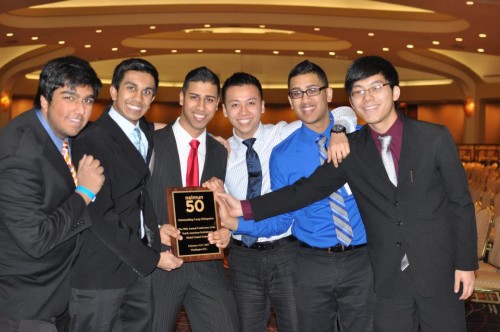
Schools can win delegation awards in Model UN. Here, J.P. Stevens High School won a delegation award at NAIMUN.
Here are several different types of awards systems that exist — the types are determined by the combination of individual and delegation (school) awards given. The model name is unofficially attributed in this article to the most prominent conference that offers it.
A. Harvard Model: the model used by Harvard MUN is very competitive because it has limited individual awards and limited delegation awards.
- Limited individual awards given in three tiers: Best Delegate, Outstanding Delegate, and Honorable Mention. (Variations of the names of each tier exist by region. For example, California uses Commendation and India uses Special Mention).
- Additionally, some conferences offer Research Awards that are independent of committee performance.
- Limited delegation awards. Typically, there are four: Best Large, Outstanding Large, Best Small, and Outstanding Small, but variations exist.
B. WorldMUN Model: the model used by WorldMUN is somewhat competitive because it only offers one tier of individual awards, thereby eliminating the scarcity of the coveted gavel.
- Limited individual awards given in one tier (Diplomacy Award).
- Limited delegation awards.
C. UChicago Model: the model used by UChicago’s MUNUC is somewhat competitive because it eliminates the existence of the coveted gavel and the existence of delegation awards.
- Limited individual awards given in two tiers: Outstanding Delegate and Honorable Mention. (One of the Outstanding Delegates receives a book to signify their higher standing, but this is not announced as a Best Delegate.)
- No delegation awards
D. Nationals Model: the model used by NMUN and NHSMUN is somewhat competitive because it mostly eliminates individual awards. Delegation awards exist in greater quantities than any of the models that offer them, thereby decreasing their scarcity.
- No individual awards. (Technically, NHSMUN does give individual awards for a few specialized committees such as Security Council, and NMUN has students nominate a few top delegates in committee but it is not a formal conference award).
- Many delegation awards in at least three tiers. (NHSMUN gives about a dozen, NMUN gives over 100 delegation awards by country assignment per conference).
E. Southern California Novice Model: the model used by SOCOMUN and other novice-only conferences in Southern California is somewhat competitive because it eliminates delegation awards and hands out many individual awards, thereby decreasing their scarcity. Judging is also notably by points based on rubrics and therefore somewhat more transparent than holistic judging at other conferences.
- Many individual awards in three tiers. This could be up to 40% or so of each committee, whereas most other conferences typically give individual awards only to the top 10-15% of committee.
- Additionally, most conferences offer Research awards based on Position Papers that are independent of their committee performance.
- No delegation awards.
F. THIMUN Model: the model used by THIMUN Hague is not competitive because it neither offers individual awards nor delegation awards. In other words, awards are not offered at all!
- No individual awards
- No delegation awards
Note #1: an argument could be made that there is still a minor element of competition at THIMUN due to a different type of scarce resource — delegates compete to a certain extent to become the main submitter so that they can gain some recognition for their applications for Secretariat and chairing positions next year. However, competition for this resource is less pronounced than competition for main sponsorship in the other models which usually leads to an individual award. Nevertheless, it is interesting how THIMUN has a scarcity of one main submitter whereas American-style conferences tend at allow four or more main sponsors to present a resolution.
Note #2: Some THIMUN-affiliated conferences do give out awards.
G. Categorical Awards model: The one model that I have seen but does not yet have a conference with at least 1,500+ delegates to represent it is the Categorical Awards model. This model is somewhat competitive because individual awards are given by category such as Best Speaker and Best Negotiator rather than by combining all delegate skills into the individual awards.
- Individual awards by category such as Best Speaker, Best Negotiator, etc.
- (Delegation awards unknown but could vary)
Conclusion
There are a variety of successful awards models and variations that conferences can pursue to shape the level of competitiveness at their conference. Variables that conferences can change include offering individual awards and/or school awards, the tiers or types of individual awards, and the quantity of individual and/or school awards. The size of THIMUN Hague proves it’s possible to be a large, prestigious conference without offering any awards — conferences could pursue this model if they truly wanted to.
Participants, particularly Faculty Advisors and Head Delegates, should give feedback to the conferences they attend so that the awards policies can reflect the educational values and level of competition that they want their delegates to experience. Secretaries-General or whoever in their Secretariat is responsible for the committee or academic experience of the conference should also put thought into this so that the educational environment matches the mission of the conference, the niche that the conference serves in the Model UN community, and other educational or cultural considerations in their region.
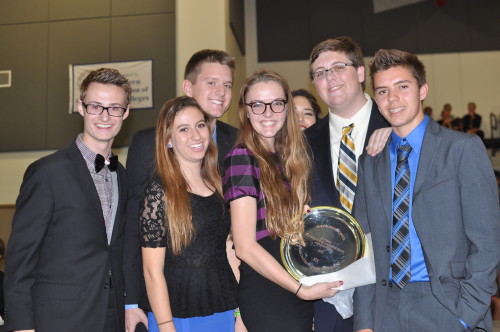
Santa Margarita Catholic High School is an example of a school that attends both competitive, awards-centric conferences and non-competitive, education-focused conferences. Their own conference, SOCOMUN, has a mix of both philosophies.
Ultimately, I believe that the spectrum of awards offered — from very competitive to no awards at all — is healthy for the Model UN community as a whole. Students have the opportunity to experience and learn from both what the world is like and what the world should be like. These different educational experiences will better prepare them for the diverse working environments they will eventually face in real life.

